| Listing 1 - 10 of 10 |
Sort by
|
Book
ISBN: 9782140287855 Year: 2023 Publisher: Paris : L'Harmattan,
Abstract | Keywords | Export | Availability | Bookmark
 Loading...
Loading...Choose an application
- Reference Manager
- EndNote
- RefWorks (Direct export to RefWorks)
Des contributions sur le concept du non narratif au théâtre, qui correspond à des pièces où rien ne se passe. Les réflexions incluent des parallèles entre la théâtralité, la littérarité et la dramaticité, et convoquent des concepts comme l'épicisation ou le théâtre rhapsodique. Les cas du théâtre d'objet, du théâtre d'images et du théâtre peint sont traités. ©Electre 2023 L'Histoire du théâtre est le tressage des histoires qu'il a su représenter depuis le fonds mythologique jusqu'au théâtre moderne. La présence de l'intrigue, l'action, le muthos et la fable en sont la parfaite illustration. Etudier le concept du non narratif au théâtre présuppose un retour à la généalogie du récit au théâtre, pour voir ses origines, son développement et son devenir. L'interrogation fédératrice de notre essai est le comment du fonctionnement de ce théâtre qui ne raconte rien, un théâtre où rien ne se passe.La réflexion porte ainsi sur les parallèles entre théâtralité, littérarité et dramaticité et sur le concept du non narratif dans ses rapports avec l'hybridité et l'intersemiosité, ce qui a généré des formes diverses à l'image du théâtre d'objet, du théâtre d'images, du théâtre peint. Bref, un théâtre post-narratif où la narration devient objet d'analyse. A l'intérieur de ce paradigme, nous avons convoqué des concepts comme l'épicisation selon P.Szondi, ou le théâtre rapsodique de J. P. Sarrazac, tout comme le monologue et ses nouvelles fonctions.
Narrative art --- Theater --- Nonverbal communication in literature --- Art narratif --- Semiotics --- Théâtre
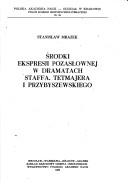
ISSN: 0554579X ISBN: 8304005506 Year: 1980 Publisher: Wrocław Zakład narodowy im. Ossolinskich
Abstract | Keywords | Export | Availability | Bookmark
 Loading...
Loading...Choose an application
- Reference Manager
- EndNote
- RefWorks (Direct export to RefWorks)
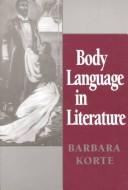
ISBN: 0802076564 0802007066 9786612003202 1282003208 1442671491 9781442671492 9780802007063 9780802076564 Year: 1998 Publisher: Toronto
Abstract | Keywords | Export | Availability | Bookmark
 Loading...
Loading...Choose an application
- Reference Manager
- EndNote
- RefWorks (Direct export to RefWorks)
In Body Language in Literature, Barbara Korte has produced an important interdisciplinary study, by establishing a general theory that accounts for the varieties of body language encountered in literary narrative, based on a general history of the phenomenon in the English language. By focusing on major works of literature, including stories by D.H. Lawrence, Margaret Atwood, and J.D. Salinger, Korte shows body language to be a vital yet unexplored method of communication in literature.
Body language in literature. --- English fiction --- Human body in literature. --- Nonverbal communication in literature. --- History and criticism. --- -Nonverbal communication in literature --- Body language in literature --- Body, Human, in literature --- 82.04 --- #SBIB:012.AANKOOP --- #SBIB:309H53 --- 82.04 Literaire thema's --- Literaire thema's --- Nonverbal communication (Psychology) in literature --- Human figure in literature --- English literature --- History and criticism --- Niet-verbale communicatie --- Human body in literature --- Nonverbal communication in literature

ISBN: 0521815649 Year: 2002 Publisher: Cambridge Cambridge University Press
Abstract | Keywords | Export | Availability | Bookmark
 Loading...
Loading...Choose an application
- Reference Manager
- EndNote
- RefWorks (Direct export to RefWorks)
Literature, Medieval --- Narration (Rhetoric) --- Nonverbal communication in literature --- History and criticism --- History --- Thematology --- Comparative literature --- anno 500-1499 --- Rhetoric --- Discourse analysis, Narrative --- Narratees (Rhetoric)
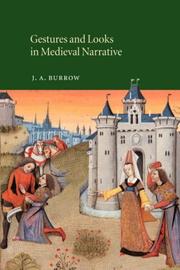
ISBN: 1107134129 0521050669 0511147937 0511325754 0511120737 0511483244 1280159707 0511045808 0511016662 9780511016660 9780511045806 9780511120732 9780521815642 0521815649 9780511483240 9781280159701 9780521050661 9781107134126 9780511147937 9780511325755 Year: 2002 Publisher: Cambridge, UK New York Cambridge University Press
Abstract | Keywords | Export | Availability | Bookmark
 Loading...
Loading...Choose an application
- Reference Manager
- EndNote
- RefWorks (Direct export to RefWorks)
In medieval society, gestures and speaking looks played an even more important part in public and private exchanges than they do today. Gestures meant more than words, for example, in ceremonies of homage and fealty. In this, the first study of its kind in English, John Burrow examines the role of non-verbal communication in a wide range of narrative texts, including Chaucer's Troilus and Criseyde, the anonymous Sir Gawain and the Green Knight, Malory's Morte D'arthur, the romances of Chrétien de Troyes, the Prose Lancelot, Boccaccio's Il Filostrato, and Dante's Commedia. Burrow argues that since non-verbal signs are in general less subject to change than words, many of the behaviours recorded in these texts, such as pointing and amorous gazing, are familiar in themselves; yet many prove easy to misread, either because they are no longer common, like bowing, or because their use has changed, like winking.
Literature, Medieval --- Nonverbal communication in literature. --- History and criticism. --- Narration (Rhetoric) --- History --- Arts and Humanities --- Literature --- Rhetoric --- Discourse analysis, Narrative --- Narratees (Rhetoric)
Book
ISBN: 3772021352 Year: 1993 Publisher: Tübingen Francke
Abstract | Keywords | Export | Availability | Bookmark
 Loading...
Loading...Choose an application
- Reference Manager
- EndNote
- RefWorks (Direct export to RefWorks)
82.0 --- Body, Human, in literature --- English fiction --- -Body language in literature --- Nonverbal communication in literature --- Nonverbal communication (Psychology) in literature --- English literature --- Human figure in literature --- Literatuurtheorie --- History and criticism --- Body language in literature. --- Human body in literature. --- Nonverbal communication in literature. --- History and criticism. --- 82.0 Literatuurtheorie --- Body language in literature --- Human body in literature
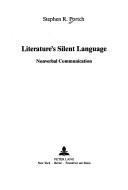
ISBN: 0820401722 Year: 1985 Publisher: New York (N.Y.): Lang
Abstract | Keywords | Export | Availability | Bookmark
 Loading...
Loading...Choose an application
- Reference Manager
- EndNote
- RefWorks (Direct export to RefWorks)
Characters and characteristics in literature --- Nonverbal communication in literature --- Short stories, American --- History and criticism --- Hawthorne, Nathaniel, --- Hemingway, Ernest, --- O'Connor, Flannery --- Criticism and interpretation. --- Criticism and interpretation. --- Criticism and interpretation.
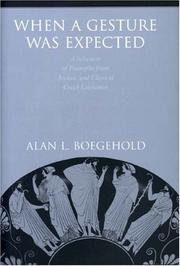
ISBN: 0691002630 9780691002637 0691252521 Year: 1999 Publisher: Princeton, New Jersey : Princeton University Press,
Abstract | Keywords | Export | Availability | Bookmark
 Loading...
Loading...Choose an application
- Reference Manager
- EndNote
- RefWorks (Direct export to RefWorks)
A boldly innovative study of nonverbal communication in the poetry and prose of Hellenic antiquityWhen a Gesture Was Expected encourages a deeper appreciation of ancient Greek poetry and prose by showing where a nod of the head or a wave of the hand can complete meaning in epic poetry and in tragedy, comedy, oratory, and in works of history and philosophy. All these works anticipated performing readers, and, as a result, they included prompts, places where a gesture could complete a sentence or amplify or comment on the written words. In this radical and highly accessible book, Alan Boegehold urges all readers to supplement the traditional avenues of classical philology with an awareness of the uses of nonverbal communication in Hellenic antiquity. This additional resource helps to explain some persistently confusing syntaxes and to make translations more accurate. It also imparts a living breath to these immortal texts.Where part of a work appears to be missing, or the syntax is irregular, or the words seem contradictory or perverse—without evidence of copyists' errors or physical damage—an ancient author may have been assuming that a performing reader would make the necessary clarifying gesture. Boegehold offers analyses of many such instances in selected passages ranging from Homer to Aeschylus to Plato. He also presents a review of sources of information about such gestures in antiquity as well as thirty illustrations, some documenting millennia-long continuities in nonverbal communication.
Greek literature --- Gesture in literature --- Nonverbal communication in literature. --- Body language in literature. --- Langage corporel dans la littérature --- Littérature grecque --- Gestes dans la littérature --- Langage du corps dans la littérature --- History and criticism. --- Histoire et critique --- Nonverbal communication in literature --- Body language in literature --- Gesture --- History and criticism --- History --- -Gesture in literature --- -Nonverbal communication in literature --- Balkan literature --- Byzantine literature --- Classical literature --- Classical philology --- Greek philology --- Mudra --- Acting --- Body language --- Elocution --- Movement (Acting) --- Oratory --- Sign language --- Nonverbal communication (Psychology) in literature --- Gesture in literature. --- History. --- Langage corporel dans la littérature --- Littérature grecque --- Gestes dans la littérature --- Langage du corps dans la littérature --- Greek literature - History and criticism --- Gesture - Greece - History --- Aeschylus. --- Agathon. --- Alcman. --- Allegory. --- Allusion. --- Andocides. --- Antithesis. --- Aorist. --- Aphorism. --- Aposiopesis. --- Aristophanes. --- Attempt. --- Author. --- Characterization. --- Concept. --- Conditional sentence. --- Consciousness. --- Consequent. --- Consideration. --- Contexts. --- Critias (dialogue). --- Critias. --- Decorum. --- Demonstrative. --- Demosthenes. --- Elaboration. --- Emblem. --- Epigram. --- Eudaimonia. --- Euripides. --- Euthyphro. --- Evocation. --- Explanation. --- Exposition (narrative). --- Facial expression. --- Fine art. --- Genre. --- Gesture. --- God. --- Gorgias. --- Haplography. --- Heliaia. --- Hermetica. --- Herodotus. --- Humour. --- Idealism. --- Illustration. --- Imagination. --- Inference. --- Irony. --- Laertes. --- Literal translation. --- Literature. --- Modal particle. --- Monadology. --- Narrative. --- Nicias. --- Nonverbal communication. --- Ontology. --- Ostanes. --- Parmenides. --- Parody. --- Philosophy. --- Phrase. --- Pindar. --- Plautus. --- Priam. --- Protagoras. --- Protasis. --- Publication. --- Punctuation. --- Quintilian. --- Quotation. --- Religion. --- Rhapsode. --- Rhetorical device. --- Sarpedon. --- Scholasticism. --- Scrutiny. --- Simulacrum. --- Sophist (dialogue). --- Sophist. --- Sophocles. --- Suggestion. --- Supplication. --- Sycophant. --- Tecmessa. --- Terence. --- Teucer. --- Theory of Forms. --- Thought. --- Thucydides. --- Timon of Phlius. --- Tiresias. --- To This Day. --- Treatise. --- Usage. --- Utterance. --- V. --- Verisimilitude.
Book
ISBN: 3631344228 9783631344224 Year: 1999 Volume: 1 Publisher: Frankfurt am Main Lang
Abstract | Keywords | Export | Availability | Bookmark
 Loading...
Loading...Choose an application
- Reference Manager
- EndNote
- RefWorks (Direct export to RefWorks)
Epic poetry, Latin --- Aeneas (Legendary character) in literature. --- Nonverbal communication in literature. --- Body language in literature. --- Gesture in literature. --- Gesture --- History and criticism. --- Aeneas (Legendary character) in literature --- Body language in literature --- -Gesture --- -Gesture in literature --- Nonverbal communication in literature --- Mudra --- Acting --- Body language --- Elocution --- Movement (Acting) --- Oratory --- Sign language --- Latin epic poetry --- Latin poetry --- Nonverbal communication (Psychology) in literature --- History and criticism --- Virgil --- Virgilio Marone, P. --- Vergilius Maro, Publius --- Vergilīĭ --- Virgile --- Vergílio --- Wergiliusz --- Vergilīĭ Maron, P. --- Vergilīĭ Maron, Publīĭ --- Verhiliĭ Maron, P. --- Vergil --- Virgilio --- Virgilīĭ --- Virgilius Maro, P. --- Virgilius Maro, Publius --- Virgil Maro, P. --- ווירגיל --- וירגיליוס --- ורגיליוס --- מרו, פובליוס ורגיליוס --- فرجيل --- Pseudo-Virgil --- Pseudo Virgilio --- Virgilio Marón, Publio --- Bhārjila --- Virgil. --- Virgilio Marone, P., --- Vergilīĭ, --- Virgile, --- Vergílio, --- Wergiliusz, --- Vergilīĭ Maron, Publīĭ, --- Verhiliĭ Maron, P., --- Vergil, --- Virgilio, --- Virgilīĭ, --- Virgilius Maro, P., --- Virgilius Maro, Publius, --- Virgil Maro, P., --- ווירגיל, --- וירגיליוס, --- ורגיליוס, --- מרו, פובליוס ורגיליוס, --- فرجيل, --- Pseudo-Virgil, --- Pseudo Virgilio, --- Virgilio Marón, Publio, --- Bhārjila, --- Gesture in literature --- Epic poetry, Latin - History and criticism. --- Gesture - Rome.
Book
ISBN: 3631490623 Year: 1996 Publisher: Frankfurt am Main Lang
Abstract | Keywords | Export | Availability | Bookmark
 Loading...
Loading...Choose an application
- Reference Manager
- EndNote
- RefWorks (Direct export to RefWorks)
Nonverbal communication in literature --- 882 "18" CEHOV, ANTON P. --- 882 "18" CEHOV, ANTON P. Russische literatuur--19e eeuw. Periode 1800-1899--CEHOV, ANTON P. --- Russische literatuur--19e eeuw. Periode 1800-1899--CEHOV, ANTON P. --- Chekhov, Anton Pavlovich, --- Чехов, Антон Павлович, --- Chehov, Anton, --- Chekov, Anton, --- Tschechow, Anton Pawlowits, --- Tchekhov, Anton, --- Czechow, Antoni, --- Tsjechov, Anton, --- Csehov, Anton Pavlovics, --- Cecov, Anton, --- Čechov, Anton Pavlovič, --- Chekhonte, A., --- Chʻi-ho-fu, --- Tjechov, Anton Pavlovitj, --- Cehov, Anton Pavlović, --- Tchekoff, Anton, --- Čexov, Anton, --- Чехов, А. П. --- Chekhov, A. P. --- Cehov, Anton Pavlovici, --- Chʻi-ho-fu, An-tung, --- Chéjov, Antón, --- Чехов, А. --- Chekhov, A. --- Chʻi-kʻo-fu, --- Tshīkūf, --- Tshīkūf, Anṭūn, --- Tšehov, A. P., --- Ts'ekhov, --- Ts'ekhov, Anṭon P., --- Tchekov, A. P., --- Tsjekhov, Anton, --- Cekhava, Enṭana, --- Čechov, A. P., --- Cekhovha, Ayāṇṭan, --- Богемский, А., --- Bogemskiĭ, A., --- Ts'ekhov, A. P., --- Tjekhov, Anton, --- טשחוב, אנטון פװלובוץ׳, --- טשעבאוו, אנטאן, --- טשעחאוו, אנטאן, --- טשעחאוו, א. --- טשעכאָװ, אנטאָן --- טשעכאוו, אנטאן --- טשעכאוו, אנטאן פּאוולאוויטש, --- טשעכאוו, אנטאן, --- טשעכאוו, א. --- טשעכאוו, א. פ. --- טשעכאוו, א. פ., --- טשעכאוו, א., --- טשעכאװ, אנטאן, --- טשעכאװ, א. --- טשעכאװ, א.פ --- טשעכאװ, א.פ., --- צ׳חוב, אנטון --- צ׳חוב, אנטון, --- צ׳חוב, א. פ. --- צ׳יחוב, א. פ. --- צ׳יחוב, א. פ., --- צ׳כוב --- צ׳כוב, אנטוון --- צ׳כוב, אנטון --- צ׳כוב, אנטון פבלוביץ׳ --- צ׳כוב, אנטון פ. --- צ׳כוב, אנתון פאבלוביץ, --- צ׳כוב, א.פ, --- צ'כוב, אנטון, --- שטעכאװ, א. פ. --- چخڤ، انتن پڤلڤچ, --- 契珂夫, --- Tsechōph, Anton, --- Cīk̲h̲auf, Antūn, --- Antūn Cīk̲h̲auf, --- Chikhūf, Āntuvān, --- Chikhūf, Āntwān, --- چخوف، آنتوان --- Dramatic works. --- Stage design. Scenography --- Chekhov, Anton P. --- 882 "18" CEHOV, ANTON P --- Russische literatuur--19e eeuw. Periode 1800-1899--CEHOV, ANTON P --- Tsjechov, Anton --- Tsjechow, Anton P. --- Čechov, Anton Pavlovič --- Chekhov, Anton Pavlovich --- Tchekhov, Anton --- Tchekhov, Antone --- Tschechow, Anton --- チェーホフ, アントーン・パーヴロヴィチ --- 체호프, 안톤 --- Чехов, Антон Павлович --- 契诃夫 --- چیخوف
| Listing 1 - 10 of 10 |
Sort by
|

 Search
Search Feedback
Feedback About UniCat
About UniCat  Help
Help News
News